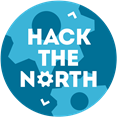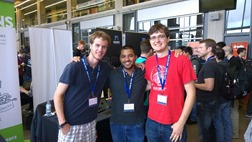Hacking the North with Microsoft Azure
 A short time ago Microsoft Canada sponsored an Azure API Challenge at the Hack The North conference. The goal of this challenge was to create some new and innovative way of using the Azure Cloud platform in under 36 hours. The participants were absolutely amazing! We got many different types of entries ranging from a collaborative music project solution to a solution for organizing your space on the web and even a voice activated toaster. In the end the team of Akshay Joshi, Jeff Gulbronson, and Stefan Wojcik won first prize with their cool hack that incorporated a few different services offered by Azure. I recently sat down with the team to talk about their project and experiences.
A short time ago Microsoft Canada sponsored an Azure API Challenge at the Hack The North conference. The goal of this challenge was to create some new and innovative way of using the Azure Cloud platform in under 36 hours. The participants were absolutely amazing! We got many different types of entries ranging from a collaborative music project solution to a solution for organizing your space on the web and even a voice activated toaster. In the end the team of Akshay Joshi, Jeff Gulbronson, and Stefan Wojcik won first prize with their cool hack that incorporated a few different services offered by Azure. I recently sat down with the team to talk about their project and experiences.
So, what exactly was the hack you guys came up with?
“Our hack, Marvin the !Paranoid Android, is a digital personal assistant for those without access to a smartphone, or have a smartphone but no data connection. The service runs through multiple interfaces, and currently supports desktop web, mobile web, voice call over PSTN and SMS messages. We tailor our responses based on the client’s interface, and our assistant will answer questions in real time. We integrated with other API's, to try and provide as much info as possible to our users. With these API's, you can ask questions ranging from: “When can I get an UBER ride?”, to “When was the French Revolution?”. You can use Marvin by texting your question to +1 226-270-1006.”
How did you incorporate Azure into your project? What services did you decide to use?
“Azure currently powers our API for all of our interfaces. The primary services that we used were Azure’s virtual machines. However, we also used Azure’s load balancing and storage services for ancillary functions.”
What were some of the challenges you faced when incorporating Azure into your project?
“One of the challenges we faced was getting the initial setup done correctly. We were having trouble with connecting to one of our instances over SSH. Although we knew exactly what the problem was, we had some trouble in finding the right place to change the virtual machine’s firewall settings.”
In your experience what are some of the highlights/lowlights of using Azure for this type of project?
“One highlight of using Azure for our service was the ease of getting instances up and running. Furthermore, Azure’s defaults allow for very easy auto scaling in the future with the way the wizard works. One lowlight, though minor, would be the lack of visibility to the exact locations of physical servers. Though cloud architecture is supposed to remove the need to know this, this is important to minimize latencies to third party services used.”
So now that you have had a little time to play around with it, do you have any plans to use Azure in the future?
“Yes. In fact, we plan on using more Azure services including the scheduler, machine learning and CDN services as we expand the product in order to offer a better user experience.”
Awesome stuff! Thanks again to Akshay, Jeff, and Stefan for taking the time to chat with me. Congratulations on your impressive hack.
Try Azure for Free!
Want to test out Microsoft Azure in your next project? Get a FREE one month trial! Sign up and get $200 to spend on all Azure services. Check out the Azure website to learn more about this offer and all the amazing features and options available with Microsoft Azure. Also, make sure you check out the getting started section for great videos on creating Virtual Machines and Websites with Azure. If you are looking for a cool project to help get you started, check out this great tutorial series on how to build a Node.JS powered real-time chatroom web app fully deployed in the cloud, “A chatroom for all!” by @RamiSayer.
